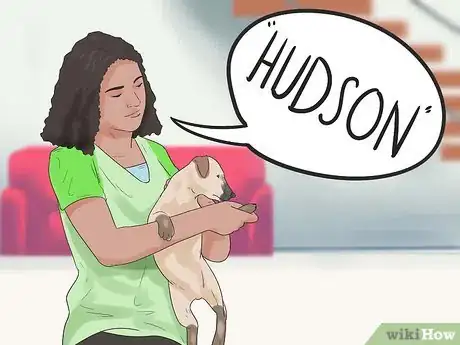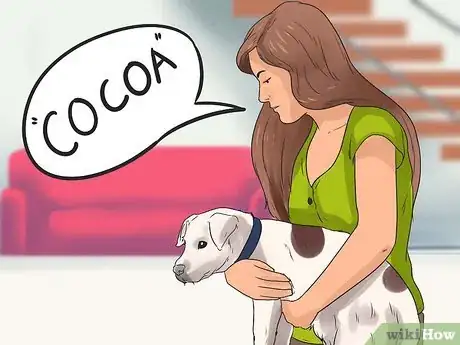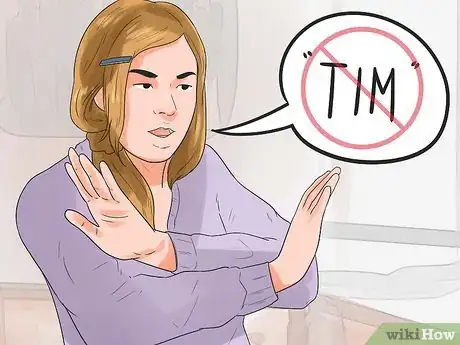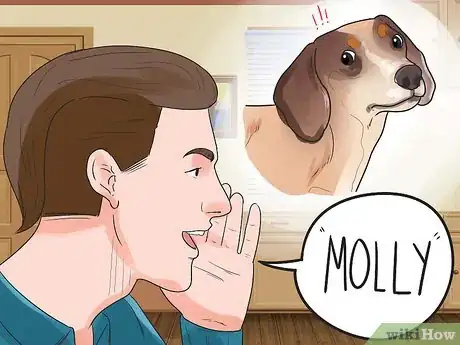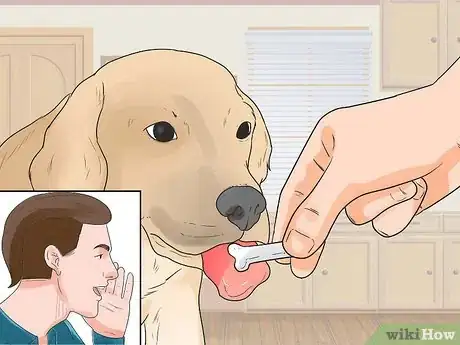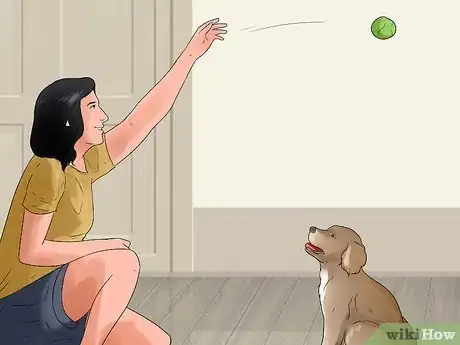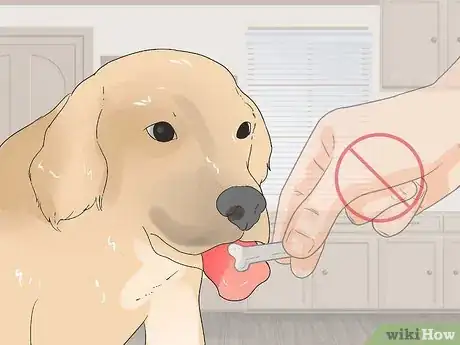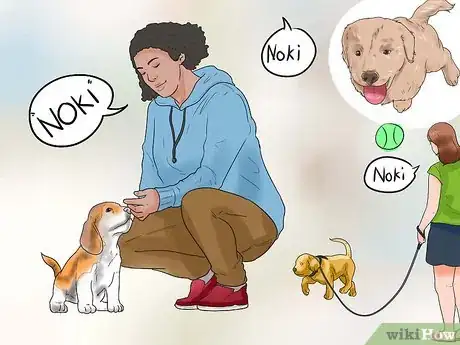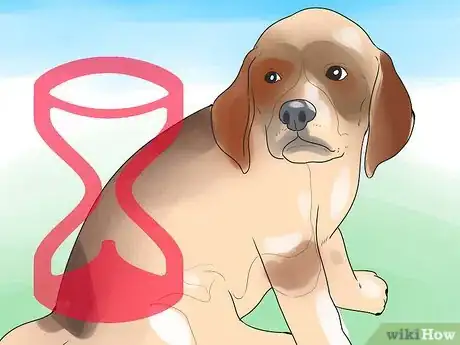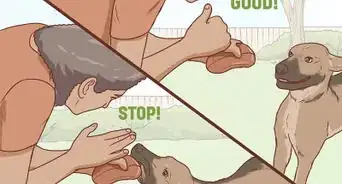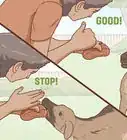This article was co-authored by Sophie Amphlett. Sophie Amphlett is a Professional Dog Trainer and Service Dog Coach with over five years of experience. Sophie graduated from CATCH Canine Trainers Academy’s Master Course with Distinction in 2016. She is also a Certified Trick Dog Instructor (CTDI) and a Certified Fun Scent Games Instructor (DN-FSG1). Sophie serves as a volunteer adoption counselor and dog walker for Adopt-A-Pet as well.
There are 9 references cited in this article, which can be found at the bottom of the page.
wikiHow marks an article as reader-approved once it receives enough positive feedback. In this case, several readers have written to tell us that this article was helpful to them, earning it our reader-approved status.
This article has been viewed 215,299 times.
Teaching a dog their name is an essential process. If your dog responds to their name, you can gain their attention for future training.[1] Additionally, you can protect them from danger and have a more harmonious household. Your obedient dog also can enjoy leash-free parks or hikes. Train your dog to respond to their name by calling them in a happy voice. Reward your dog when they come to you upon hearing their name. Be consistent and patient and your dog should learn their name quickly.
Steps
Choosing Your Dog's Name
-
1Get to know your dog. Spend a few days with your dog before deciding on a name. Play with them and see what they like and dislike. For example, during which activities do they wag their tail or seem excited? In which moments do they seem withdrawn? Are there particular food they prefer? After some time, you both will be more comfortable with each other. You might draw a name from their personality traits or habits. If your dog has lots of energy, you could name them Sparky for instance.
- It is important to teach your dog their name before you begin teaching commands. Having your dog know their name will help the training process.[2]
-
2Choose a name with one or two syllables. A dog’s name should produce a quick response. Dogs respond better to short sounds. For example, ideal dog names are Bella, Buddy, or Lucky. Use a name that you will not mind repeating endlessly. Allow household members to contribute to the naming process. If you have small children, consider picking a shorter name that they can say.[3]Advertisement
-
3Select a name with distinguishable sounds. By having easily identifiable sounds in the name, the dog can differentiate their name from surrounding noise. Utilize names with crisp, commanding consonants (“k” or hard “c”) like "Cocoa." Sibilant consonant or blends (“s,” “sh” or “zh”) in names like "Shadow" also help dogs hear their names. Consider names like BeeBee with distinct vowel sounds.[4]
-
4Avoid names that rhyme with frequently used words. For example, do not choose a name that rhymes with a household member's name (e.g. Jim, name: Tim), an often-used word (No!, name: Bo), or command (Stay, name: Shay). If the name sounds too close to another word, the dog might be confused. Your dog does not understand the meaning behind their name. Instead, your dog responds in a particular way to a certain sound.[5]
Training Your Dog to Respond to their Name
-
1Call your dog's name in a happy, clear voice. Use your dog's name one time per exercise (e.g. Come, Molly!). If you repeat the name continually before the dog comes, they will tune the name out.[6] Use the dog's name with positive commands.
- Consider running away from your dog while you call his name. Dogs love to chase things and might be more likely to follow you.[7]
- Use the Name Game to practice name recognition. In the training area, keep them on a ten-foot leash. Give them five feet to wander. When they are not looking, call the dog with an excited voice. Make sure they come to you. If they do not come, pull them gently towards you. When they get to you, praise them and give them a treat. Repeat the exercise until your dog consistently returns to you when you call their name.[8]
- Do not use the dog's name in conjunction with negative commands or words (no and stay). Do not scold the dog if they take a while to come to you.[9]
- Avoid nicknames that might confuse your dog, like "Come!" and "Stop!" These might sound funny, but they'll only lead to distress.[10]
EXPERT TIPDr. Elliott, BVMS, MRCVS is a veterinarian with over 30 years of experience in veterinary surgery and companion animal practice. She graduated from the University of Glasgow in 1987 with a degree in veterinary medicine and surgery. She has worked at the same animal clinic in her hometown for over 20 years.Veterinarian
 Pippa Elliott, MRCVS
Pippa Elliott, MRCVS
VeterinarianPippa Elliott, a licensed veterinarian, suggests: "Consider have a 'good dog' and a 'bad dog' name. This avoids using the name the puppy associates with good things when the puppy has done something bad. By having a separate 'bad dog' name, the pup won't then link the 'good' name to negative emotions."
-
2Reward your dog if they respond to their name.[11] Say, "yes!" when he comes.[12] Give them verbal praise and/or a treat. Overall, act very excited and pleased about their behavior. You also could give your dog a belly rub. You can alternate what rewards you give the dog. The goal is to associate dog's obedience with a positive response from you.
Reinforcing Name Recognition
-
1Make training more challenging. After your dog has mastered initial training, train in different locations. Throw in a distraction like a bouncing ball, then call their name. Practice while your dog is playing, chewing, grooming, sleeping, etc.[13] Aim to have your dog respond to you no matter where you are.
-
2Stop giving treats gradually. Once your dog consistently responds to their name, slowly stop giving them treats (for name response). Give them a treat every other time they respond. Lengthen the time between treats until they no longer need treats for name response.
-
3Use the dog's name continually. Once you are done training, continue using the dog's name frequently. Say it when you walk, feed, bathe, or groom him. Say their name during positive moments.
-
4Give it time. If it takes a while for your dog to learn their name, that is okay. Each dog learns at their own pace. The key is to be consistent in saying their name. Over time, they will learn to understand that when they hear their name, you want their attention.
Expert Q&A
-
QuestionCan I use a clicker to do this?
 Sophie AmphlettSophie Amphlett is a Professional Dog Trainer and Service Dog Coach with over five years of experience. Sophie graduated from CATCH Canine Trainers Academy’s Master Course with Distinction in 2016. She is also a Certified Trick Dog Instructor (CTDI) and a Certified Fun Scent Games Instructor (DN-FSG1). Sophie serves as a volunteer adoption counselor and dog walker for Adopt-A-Pet as well.
Sophie AmphlettSophie Amphlett is a Professional Dog Trainer and Service Dog Coach with over five years of experience. Sophie graduated from CATCH Canine Trainers Academy’s Master Course with Distinction in 2016. She is also a Certified Trick Dog Instructor (CTDI) and a Certified Fun Scent Games Instructor (DN-FSG1). Sophie serves as a volunteer adoption counselor and dog walker for Adopt-A-Pet as well.
Professional Dog Trainer Yes! Using a clicker might make the process go faster. Just say your dog's name, click, and then immediately give your dog a treat. After you do this over and over, the dog should start looking at you when you say their name. At that precise moment, click and give them a treat.
Yes! Using a clicker might make the process go faster. Just say your dog's name, click, and then immediately give your dog a treat. After you do this over and over, the dog should start looking at you when you say their name. At that precise moment, click and give them a treat.
References
- ↑ http://www.labradortraininghq.com/labrador-training/how-to-teach-a-puppy-its-name/
- ↑ https://rogerabrantes.wordpress.com/2011/11/09/the-first-ten-skills-you-should-teach-your-puppy/
- ↑ http://www.petmd.com/dog/puppycenter/adoption/evr_dg_naming_your_puppy
- ↑ http://www.nytimes.com/2013/04/04/garden/the-art-of-naming-a-dog.html?pagewanted=2&_r=1
- ↑ http://www.petmd.com/dog/puppycenter/adoption/evr_dg_naming_your_puppy
- ↑ http://www.dogtime.com/teaching-name-recognition.html
- ↑ https://www.aspca.org/pet-care/virtual-pet-behaviorist/dog-behavior/teaching-your-dog-come-when-called
- ↑ http://www.puppyintraining.com/how-to-teach-your-puppy-his-name/
- ↑ http://www.puppyintraining.com/how-to-teach-your-puppy-his-name/
- ↑ http://www.labradortraininghq.com/labrador-training/how-to-teach-a-puppy-its-name/
- ↑ Sophie Amphlett. Professional Dog Trainer. Expert Interview. 30 December 2020.
- ↑ http://www.petfinder.com/dogs/dog-training/teaching-dog-come-called/
- ↑ http://www.puppyintraining.com/how-to-teach-your-puppy-his-name/
- ↑ https://www.aspca.org/pet-care/virtual-pet-behaviorist/dog-behavior/teaching-your-dog-come-when-called
- ↑ https://www.aspca.org/pet-care/virtual-pet-behaviorist/dog-behavior/teaching-your-dog-come-when-called
About This Article
To teach a puppy its name, try a simple exercise by putting the dog on a leash and calling it when its not looking. When the dog comes to you, give it a treat as a reward. Once your dog starts responding to its name, try calling it when it's distracted, like while playing with a ball, to test your dog's ability to concentrate. To help your dog recognize its name, use the name as much as possible, including when you're giving it food. You should also be consistent and patient with your puppy, since it can often take time for them to learn their name. For tips on how to choose a good name for your puppy and what to do if it doesn't respond to it, read on!

